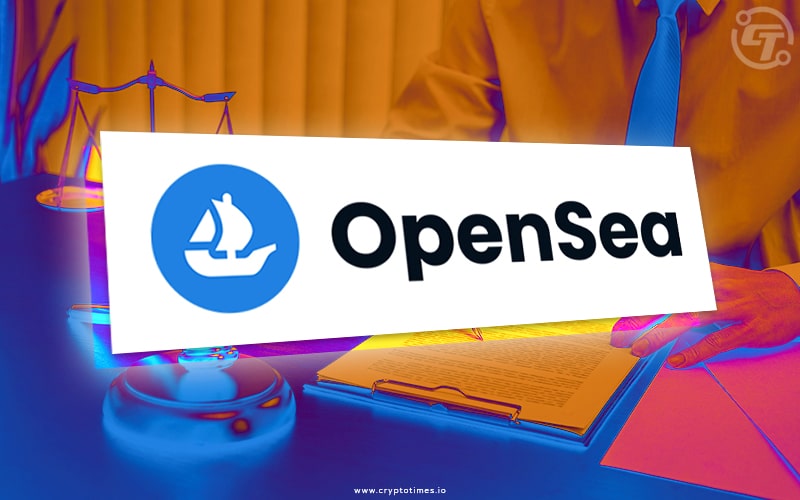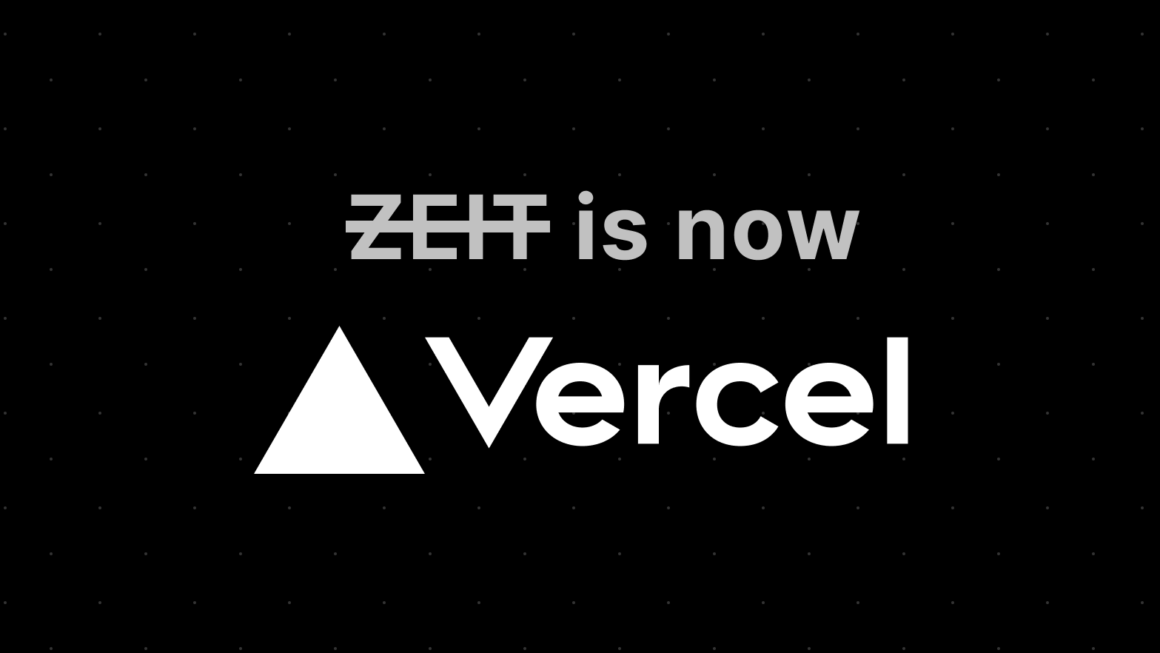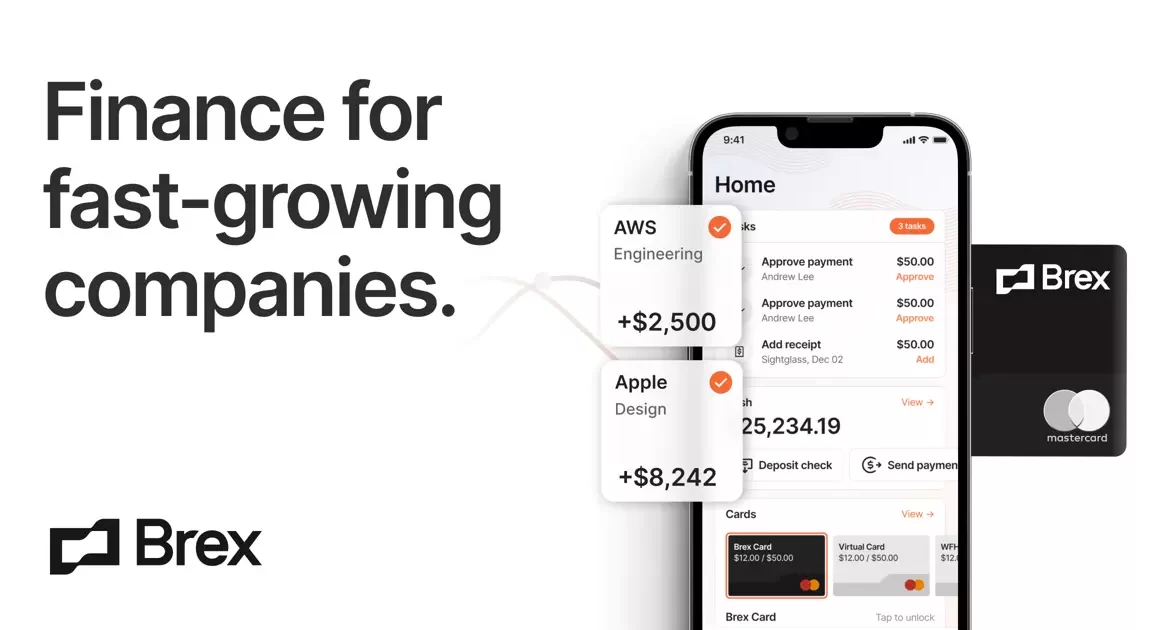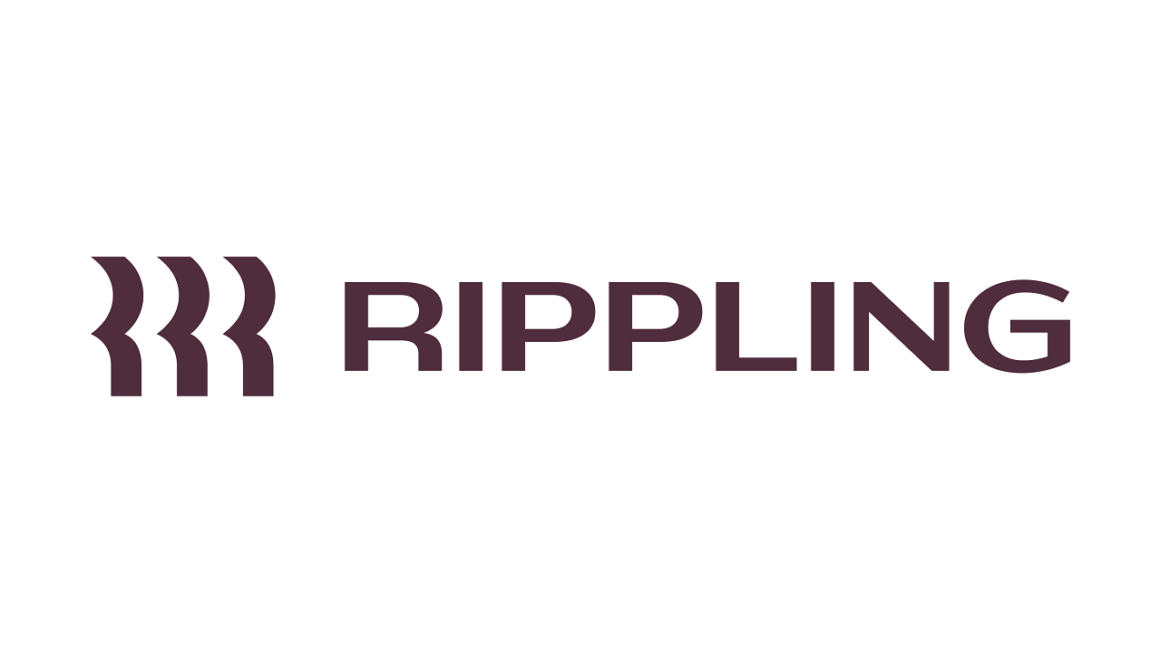What is Opensea?
OpenSea is a revolutionary decentralized marketplace for purchasing and selling NFTs. If you’re wondering what NFTs are, they’re unique, collectible digital stuff like in-game assets, avatars, trading cards, and art.
OpenSea reported NFT trading volume of more than $3.5 billion in just August 2021. Given that its total volume for 2020 was just $21 million, it is reasonable to state that the increase in trading activity of 12,000% clearly indicates success.
OpenSea’s valuation has increased to over $1 billion thanks to investors like Mark Cuban, Kevin Durant, Ashton Kutcher, and crypto juggernaut a16z, almost overnight making the nascent NFT platform a unicorn.
NFT investors, traders, collectors, and artists all give OpenSea great marks, but if you’ve never used the platform before, it might be very perplexing. This introduction to OpenSea provides you with a simple overview of NFTs, what OpenSea is and how to use it, as well as some of the top NFTs available today.
First, let’s explain NFTs (Non-Fungible Tokens)
Understanding NFTs before going into OpenSea can save you time and confusion later on. NFT stands for Non-Fungible Token. That doesn’t tell you much, and there’s a lot to unpack, so let’s begin at the beginning.
A fungible token is a digital currency, such as Bitcoin, that may be traded interchangeably. Because fungible tokens are not unique, a Bitcoin is always equivalent to any other Bitcoin. The same is true for conventional currency. Because dollar notes are interchangeable, neither of you loses anything if you swap them.
A non-fungible token, on the other hand, symbolizes a one-of-a-kind digital item. Consider CryptoPunks profile image avatars, Axie Infinity in-game goodies, and original digital artworks. As a result, if you have a CryptoPunk NFT and a buddy has a Bored Ape YC NFT, they are not transferable in the same way as currencies are since they are separate digital things.

NFTs have captivated digital creators of all stripes because they enable proven ownership of digital assets for the first time. Furthermore, they allow artists and collectors to trade directly with one another, which is what OpenSea’s peer-to-peer NFT market is all about.
What is OpenSea NFT Marketplace?
OpenSea bills itself as the first and largest NFT marketplace in the world. To put it another way, OpenSea is like eBay for digital artifacts and treasures.
Alex Atallah and Devin Finzer established OpenSea in New York City in 2017. Soon after, they applied to the renowned Y Combinator startup incubator and obtained a $2.7 million investment.
Early on, the OpenSea crew had a lot to prove. Apart from early fads like CryptoKitties, NFTs were failed to catch on until 2021. However, the team’s prediction that consumers would eventually value digital things as highly — if not more — than real ones began to come true. Here’s some context to help you grasp what OpenSea is.
Trading in cryptocurrency tokens laid the groundwork for the present NFT boom. People throughout the world exchange digital cash and utility tokens around the clock. They are at ease with digitally owning objects they cannot see or feel, signaling that the digital native era has arrived.
Founders / Opening Story of Opensea
The CEO and CTO of OpenSea, Devin Finzer, caught the entrepreneurial bug while still in college. Before becoming obsessed with the cryptocurrency sector, both Brown and Stanford students studied computer science, founded startups relating to college life, and worked as software developers at their respective colleges.
Together, they presented a cryptocurrency proposal at TechCrunch’s Hackathon and were accepted into Y Combinator in late 2017. After watching the release of CryptoKitties, one of the first-ever NFT collections, with individual NFTs selling for over $100,000, the team at YC began developing a “marketplace for the metaverse.”
After their change of direction, they started to face up against Rare Bits, another startup. Both businesses characterized themselves as “eBay for crypto,” raised roughly comparable amounts of money, and made their Product Hunt debuts on the same day. The next year, OpenSea operated with a small staff and levied fees as the bitcoin market entered a period of low activity. While Rare Bits lost money by not collecting transaction fees. In the end, Rare Bits shut down in 2019, allowing OpenSea to dominate the NFT business.
Business Model of Opensea
The 2.5% take rate on the price of all transactions is how OpenSea’s marketplace largely generates revenue. These payments are required for the exchange of ERC721 or ERC1155 NFTs. The “creator profits %,” which may be adjusted when someone creates an NFT, controls how much money that person makes each time that NFT is exchanged. The creator profits setting should be set at 2.5%, according to OpenSea.
OpenSea offers data, leaderboards, and other features that promote the beginning and growth of an NFT collection in order to encourage additional transactions. Their platform aims to enhance the volume of transactions and the number of consumers interested in purchasing NFTs.
Growth Story of Opensea
Up until October 2019, OpenSea’s monthly trade volume stayed close to $500,000. Before seeing its first 10-fold increase to $96 million in February 2021, its volume increased to $8 million in January 2021. In August 2021, OpenSea’s volume increased by a factor of 10 and increased from $300 million to $3 billion. Their monthly trade volume remained over $2 billion for the following nine months, but in June 2022, it decreased by around 73%, from $2.6 billion to $695 million. Despite the fact that this is still significantly greater than the trade volume in June 2021, the volumes in the subsequent months of July and August fell even more to $500 million. The boom and bust of the cryptocurrency cycle may be used as an explanation for the ups and downs in trade volume on OpenSea.
The number of new users joining hasn’t significantly decreased, despite the recent downturn in trading volumes. The graph on the bottom right demonstrates that from its initial inflection point in August 2021, the pace of new members joining the platform has followed a nearly linear trend. It is difficult to determine the LTV of OpenSea users due to the lack of data on user retention and engagement.
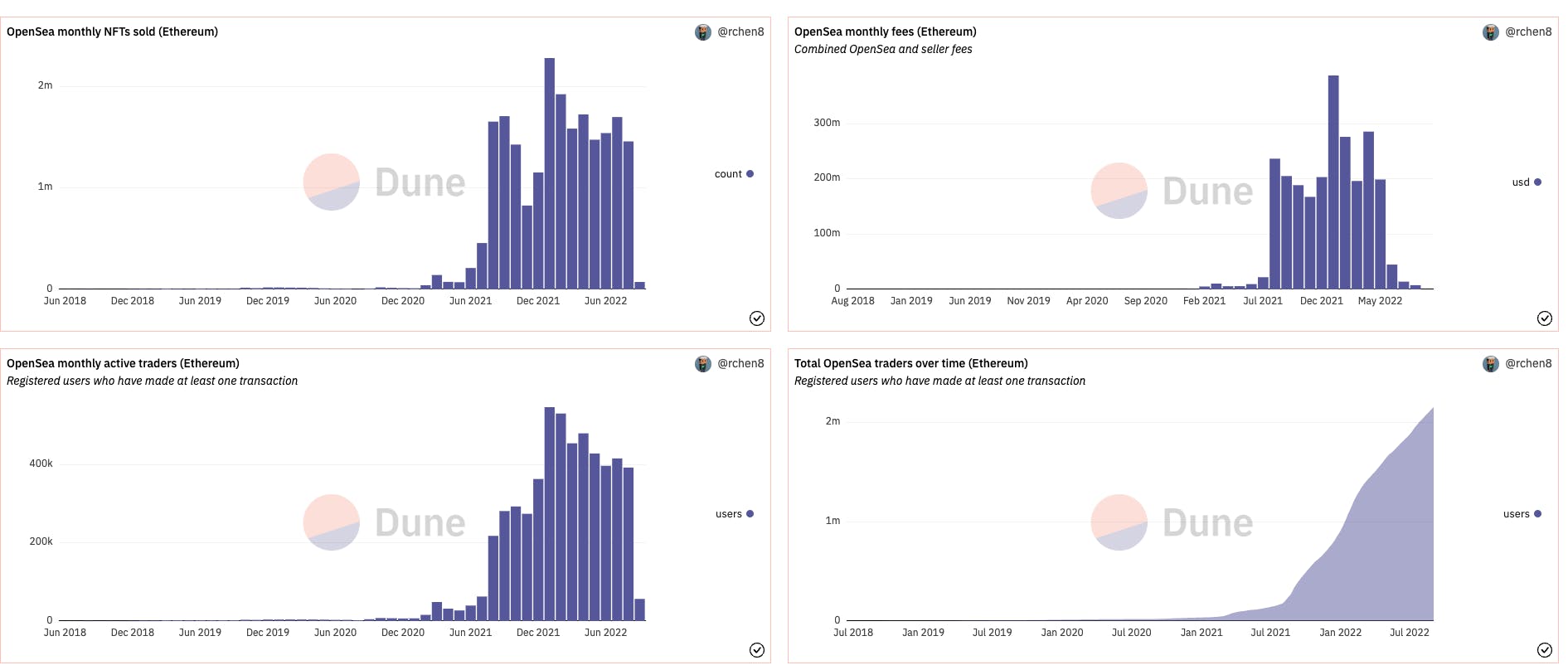
Source: Dune
Valuation/Funding of Opensea
On January 4, 2022, OpenSea received $300 million in Series C investment from Paradigm and Coatue at a $13.3 billion post-money value. Their Series C value is eight times more than the sum they received in investment in July 2021 ($100 million at a16z’s $1.5 billion post-money valuation).
Also Read: Plaid – Success Story, Business Model, Revenue Growth & Funding
Competition of Opensea
In the NFT marketplace sector, OpenSea still holds the lion’s share of the market, but Magic Eden and LooksRare are challenging the firm.
Magic Eden
The Solana NFT ecosystem is firmly in the control of MagicEden. OpenSea’s attempts to get a foothold in the Solana NFT market have kept it trapped at less than 3% of the volume that MagicEden sees since the establishment and subsequent expansion of the Solana NFT ecosystem.
In the cryptocurrency industry, native exchanges frequently outperform cross-chain competitors. Examples include QuickSwap on Polygon, DeFi Kingdoms on Harmony, and others. OpenSea’s loudness appears to increase when Magic Eden’s volume does too, but less noticeably.
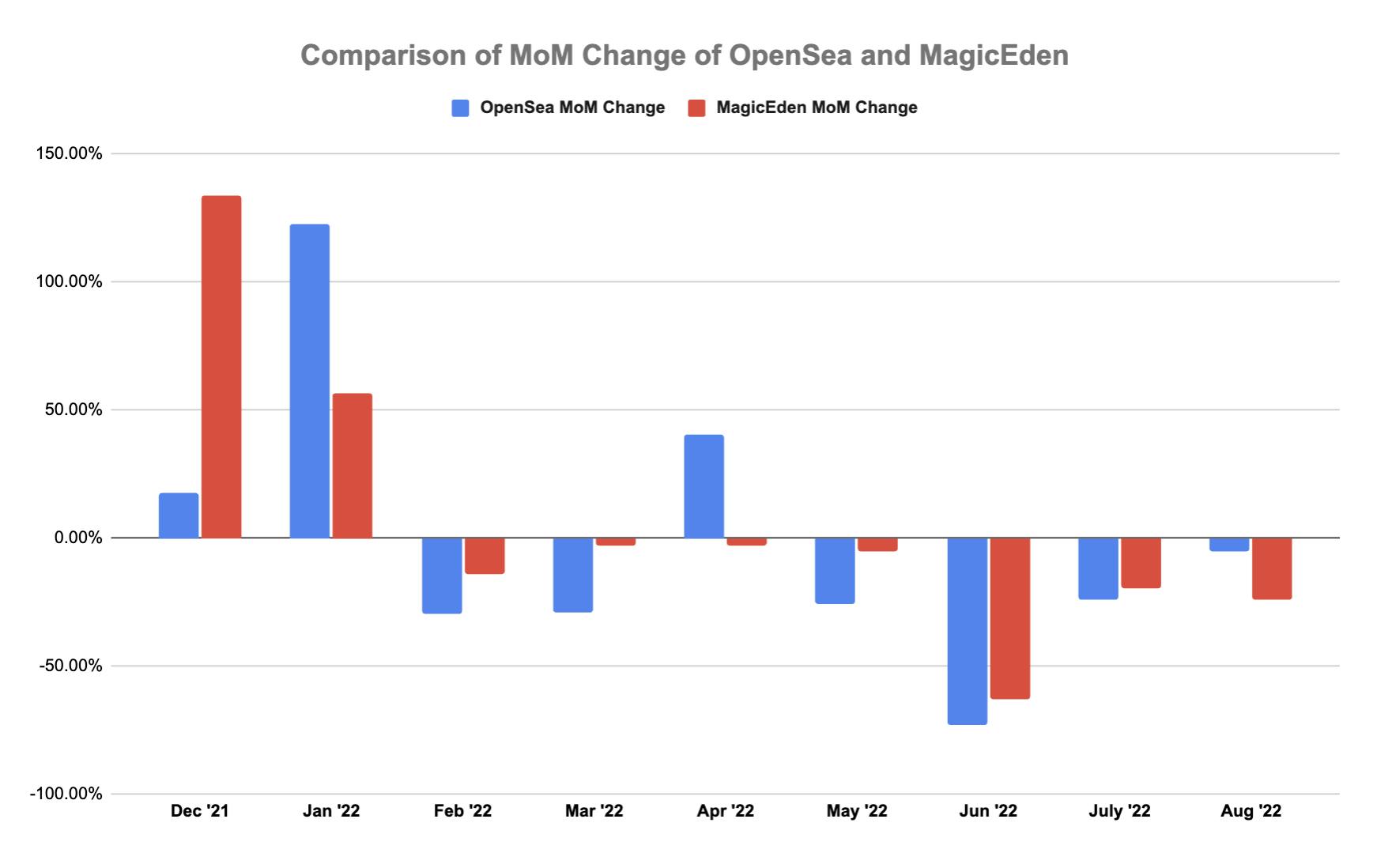
LooksRare
In January 2022, a vampire assault on OpenSea was started by LooksRare, an Ethereum-based NFT Ecosystem. The vampire assault included indexing every NFT on Ethereum (i.e., everything on OpenSea), making them instantly tradeable, and duplicating the ecosystem as a result. LooksRare attracted a lot of interest by giving awards and their own LOOKS token, and within the first 24 hours of its introduction, sold NFTs valued at $105 million.
The LOOKS token was really “wash traded” for the majority of volume on LooksRare. Sites like The Block keep track of how much of LooksRare’s volume was not wash trading as well as how much volume remains once wash transactions are removed. The average actual volume for the first several months after its inception, according to The Block, has continuously been about 40% of its total, coming to about $45 million every month. This wasn’t insignificant despite being considerably less than OpenSea’s $650 million. OpenSea may encounter difficulties differentiating its product from the competition if LooksRare maintains its market share and offers greater financial incentives.
Future of Opensea
Cross-Chain NFTs
Although they recently announced their Solana Launchpad in July 2022, which is a platform that allows creators to launch collections to their communities, OpenSea’s volume is largely Ethereum-based.
Additionally, they enable users to link their Phantom or Glow wallets, which are Solana wallets, and establish an account. Even though OpenSea hasn’t been able to capture more than 2% of the Solana NFT trading volume, future blockchains like Solana offer enormous potential for expansion.
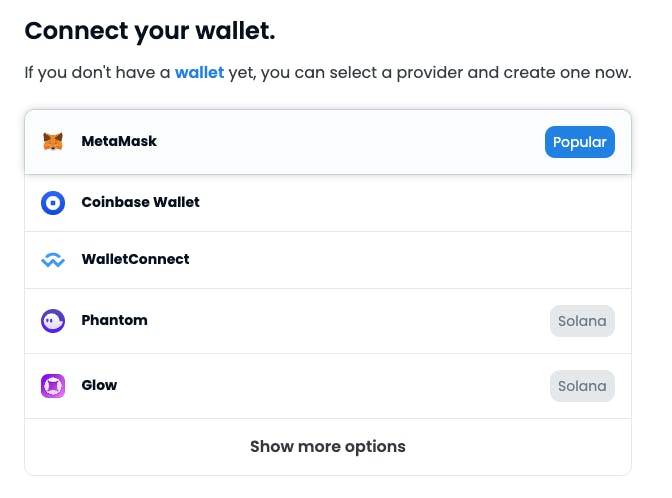
Cross-chain NFTs present a potential opportunity for OpenSea to carve a wedge into other blockchains with their existing primarily Ethereum-based user base if blockchains outside of Solana start to gain traction.
The purchase of Gem by OpenSea in April 2022 signaled the company’s ambition to develop a first-rate NFT trading environment. Gem provides a platform for consumers to easily purchase NFTs from a variety of markets for a modest charge. OpenSea stated the following regarding their plans to develop a “pro” experience on their platform at the time they acquired Gem:
Our goal at OpenSea is to make NFTs more accessible to individuals all across the world. As the NFT community expands, we’ve seen a need to better serve more seasoned, “pro” users and provide users of all skill levels greater freedom and options.
Given how challenging it would be to balance a portfolio of $100K+ assets, OpenSea may provide a premium solution that offers deeper insights or fractional ownership of NFTs. Depending on the target market, OpenSea may make it possible for this product to let expert traders establish more complex financial positions.
To read more content like this, subscribe to our newsletter
